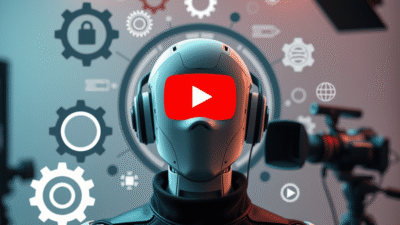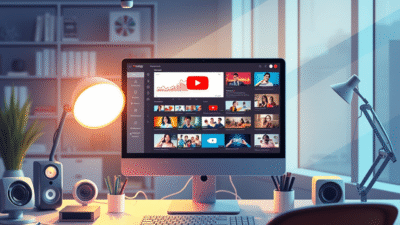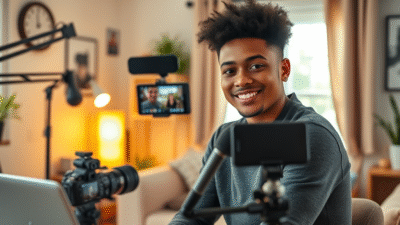YouTube has always been a platform that evolves with technology, from the rise of HD video to the introduction of Shorts. But the next big shift on YouTube is not just about video format. It is about who, or rather what, is creating the content.
The future of YouTube is pointing toward AI powered avatars and virtual creators, reshaping how audiences consume content and how creators build influence.
Why AI Avatars Are Taking Over
AI avatars are no longer science fiction. They are hyper realistic digital personas generated by artificial intelligence that can look and act like humans or entirely unique characters. These avatars can speak, express emotions, and even adapt their style of communication depending on the audience. With tools like Synthesia, HeyGen, and DeepBrain AI becoming mainstream, more creators are experimenting with virtual hosts instead of filming themselves on camera.
The shift is happening because AI solves many challenges creators face. Not everyone feels comfortable showing their face or speaking on camera, but with an AI avatar, anyone can launch a channel. Production costs also drop significantly because there is no need for studio lighting, filming equipment, or endless reshoots.
The Rise of Virtual Influencers
We have already seen virtual influencers gain popularity on platforms like Instagram and TikTok. Characters like Lil Miquela and Imma are fully digital, yet they attract millions of followers and brand deals from companies like Prada and Samsung. YouTube is the natural next step for this trend because video storytelling allows these avatars to come alive in ways that static social posts cannot.
Virtual creators can upload daily, appear in multiple languages, and even run multiple channels at once. Brands are drawn to them because they are fully controllable. Unlike human influencers, they never get tired, never get caught in scandals, and always stay on message.
How AI Avatars Will Change YouTube Content
The shift toward AI powered creators will not just replace human faces; it will transform the types of content that dominate YouTube. Imagine educational channels where a friendly virtual teacher explains physics in ten different languages without needing subtitles. Picture gaming channels where digital hosts react with heightened expressions, making content even more entertaining.
We will also see storytelling evolve. Virtual creators can adopt multiple identities, switching between characters that fit different narratives. A single person could run an entire cast of avatars, building rich story-driven channels that rival TV shows.
Opportunities for New Creators
The most exciting part of AI powered avatars is the democratization of YouTube content creation. For years, starting a channel meant investing in cameras, lights, microphones, and editing software. Now, with AI avatars, a laptop and an internet connection are enough. Anyone can generate a digital character, write a script, and publish professional looking videos in hours instead of weeks.
This levels the playing field for people who want to share ideas, knowledge, or entertainment but do not have the budget or confidence to appear on screen. Niche communities will flourish because the barrier to entry is lower than ever before.
Monetization and Brand Deals with Virtual Creators
YouTube monetization will adapt to include AI avatars just like it did with animations and faceless commentary channels. Viewers care about consistency, storytelling, and value, not necessarily whether the person on screen is human. In fact, virtual creators may be more appealing to brands because they can be customized to perfectly align with brand aesthetics.
Imagine a tech company hiring a futuristic avatar to review its latest devices or a fitness brand working with a digital trainer who demonstrates workouts flawlessly. Sponsorships, affiliate marketing, and even merchandise will expand into avatar powered branding. Virtual characters can appear on T shirts, plush toys, or even in augmented reality apps.
Challenges Ahead for AI Powered YouTube
Of course, this future is not without challenges. Audiences may initially be skeptical of connecting emotionally with digital avatars. There is also the ethical question of transparency. Should creators disclose when they are using AI avatars? Should viewers be told if a video is fully AI generated?
YouTube may also need to update policies to address potential misuse, such as deepfake avatars impersonating real people or AI voices spreading misinformation. Another concern is market saturation. If thousands of AI avatar channels flood the platform, standing out will be harder, and originality will matter even more.
How to Start a YouTube Channel with AI Avatars
For aspiring creators, the opportunity is wide open right now. Getting started with an AI powered channel involves a few steps. First, choose a niche where avatars feel natural, such as education, gaming, tech reviews, or storytelling. Then, select an AI avatar generator like HeyGen, Synthesia, or Colossyan to create your digital host. Write engaging scripts, pair them with voice AI tools like ElevenLabs or Play.ht, and edit your content using software like Descript or CapCut.
The key is consistency and branding. Give your avatar a unique style, voice, and backstory that makes them memorable. Promote your channel across social media, especially TikTok and Instagram Reels, where short avatar clips can attract audiences to your YouTube channel.
The Future of Community Building
One of the biggest questions is whether audiences will form real connections with virtual creators. The answer is already visible in communities built around VTubers on YouTube and Twitch. VTubers, who use animated avatars instead of showing their faces, have created massive fan bases. Fans attend live streams, buy merchandise, and even support them financially through memberships and donations.
AI powered avatars will expand this model. Communities will rally around their favorite virtual hosts, and creators will experiment with interactive experiences, such as letting viewers vote on an avatar’s style or storyline. The bond may not be about the person behind the screen but about the character they bring to life.
Looking Ahead: The Next Five Years of YouTube
In the next five years, AI powered avatars will become a mainstream part of YouTube. Some channels will be fully virtual, while others may blend human hosts with AI characters. We will likely see collaborations between human influencers and digital ones, creating entirely new formats of entertainment.
The line between creator and creation will blur. Instead of following a person, audiences may follow a character that exists across YouTube, TikTok, Instagram, and even the metaverse. Brands will build long term relationships with digital influencers, and creators who embrace this trend early will have the advantage.
Conclusion
The future of YouTube is not just about better cameras or faster editing. It is about reimagining what it means to be a creator. AI powered avatars and virtual influencers are opening new doors for storytelling, monetization, and community building. While challenges exist, the opportunities are far greater.
For aspiring creators, this is the perfect moment to explore the world of digital hosts and virtual identities. The creators who adapt to this new landscape will shape the next era of YouTube, where reality and virtual creativity merge into one.


